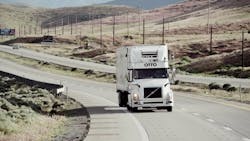Living on the West Coast, my mornings consist of a mad scramble to catch up on news I’ve missed while sleeping. With so many news outlets and social media sharing, it can be a maddening process.
This past Monday was a perfect example of how confusing it can be, when I awoke to dozens of stories offering a first look at Uber Freight. With great anticipation I started clicking on the headlines, only to find a photo of a single tractor-trailer tweeted by Uber CEO Travis Kalanick and the words “So much great stuff going on!”
Talk about a great disappointment!
Like many people, I’ve been amazed how successfully Uber disrupted the passenger transport space in such a short time. My intrigue grew last fall when Anthony Levandowski, the co-founder of Otto, agreed to participate in a panel I moderated at American Trucking Associations annual conference. It took place just months after Uber bought the company for $680 million.
Those in attendance heard Levandowski share his vision of tractor-trailers running around-the-clock without the need for truck cabs – or drivers. He also outlined the basics of Uber Freight, and urged truckers to reach out to him if they were interested in getting involved.
Afterwards, Levandowski sat down with me and several colleagues for an interview. He picked apart in great detail and even greater confidence how Uber’s technologies will take advantage of the inefficiencies in today’s trucking market.
“Change is always scary, but people need to understand . . . automation is going to happen,” he declared.
Though he provided zero indication Otto’s autonomous beer delivery in Colorado was only a month away, I certainly was not shocked to see them pull it off.
With that in mind, and during a period of unemployment earlier this year, I became an Uber driver in my new home of Portland, OR. Over the next three months, I completed about 500 passenger trips. I also did food delivery – the closest I could get to replicating Uber Freight.
It was a fascinating experience, allowing me to better understand Uber’s technology, and to question how the safety programs of ride-sharing services compare with the trucking industry. I hope to share these and other takeaways from my experiences in this space in the months ahead.
Getting back to Kalanick’s tweet, I’m still left wondering if there was any news? Some have pointed out seeing an Uber Freight branded trailer indicates a different business model than what was previously suggested. But who really knows?
In the end, it seems the tweet was nothing more than a publicity stunt. If so, it probably was a wise move. This year has been anything but kind to Uber. Controversy has plagued the company at almost every turn this year, including in the truck space, where Google spin-off Waymo is suing over potentially stolen data related to autonomous technologies.
Levandowski, a former Google employee, has been forced to step aside as head of Uber’s autonomous division for the time being, and a federal court decision on a temporary injunction that could block Uber’s self-driving car efforts is expected any day now.
Without question, companies like Uber, Google and Amazon are undertaking efforts that, along with today’s more established truck makers and software providers, could forever alter trucking and transportation. Among younger people, vehicles like the Freightliner Inspiration truck are making trucking cool and chic — for the first time in their lives.
But this all comes with some down side. Just last week, a high-level executive at a large national trucking fleet told me some of drivers are expressing concern about their job security with all the talk of driverless trucks. He assured them they have nothing to worry for a very, very long time.
Most of us know that is 100 percent accurate. So we should make sure our reactions to any single tweet do not give off the impression that the next big thing has truly arrived - yet.
About the Author
Neil Abt
Neil Abt is a former FleetOwner editor who wrote for the publication from 2017 to 2020. He was editorial director from 2018 to 2020.
